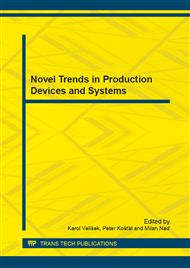p.411
p.417
p.423
p.430
p.436
p.442
p.448
p.454
p.460
Numerical Study of the Influence of Surface Regular Asperities Prepared in Previous Treatment by Embossing Process on the Object Surface Layer State after Burnishing
Abstract:
Generally advantages of superficial plastic processes are well-known (smooth, strain hardening of surface, the low unite price and large repeatability of product quality), but industrial application it procures many difficulties. The lack of suitable methods of preparation surface, unequivocally guidelines concerning on preparations of surface under processing and data about choice of technological parameters are the basic problems. In aim of enlargement the product's quality not only enlargement of burnished product accuracy, but also enlargement of surface preparation accuracy about regular geometrical structure after previous treatment are needed. The paper concerns on the suitable semi-finished product surface preparation under finishing burnishing rolling. New method of surface preparations under burnishing rolling consisted in embossing of surface regular asperities. The physical, mathematical and computer model of the process was elaborated with the assumption geometrical and physical nonlinearities. The application in ANSYS/LS-DYNA program enabling the investigation of influence: friction conditions in tool-workpiece contact zone, the value and type of material hardening on the displacement, strain and stress state in object was elaborated. The results of computer simulations can be used to forecasting quality of the parts optimization.
Info:
Periodical:
Pages:
448-453
Citation:
Online since:
January 2014
Price:
Сopyright:
© 2014 Trans Tech Publications Ltd. All Rights Reserved
Share:
Citation:


